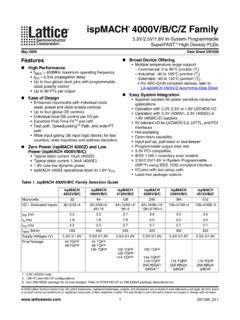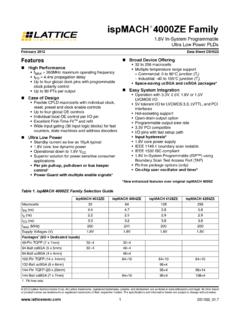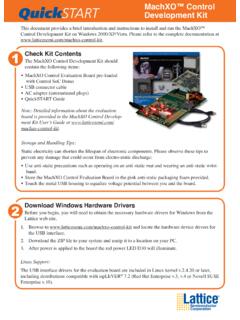Transcription of ispMACH 4A CPLD Family - Lattice Semiconductor
1 ispMACH 4A cpld Family High Performance E2 CMOS Lead- In-System Programmable Logic Free P ckage a Options Available! FEATURES. High-performance, E2 CMOS & 5-V cpld families Flexible architecture for rapid logic designs Excellent First-Time-FitTM and refit feature SpeedLockingTM performance for guaranteed fixed timing Central, input and output switch matrices for 100% routability and 100% pin-out retention High speed tPD Commercial and tPD Industrial 182 MHz fCNT. 32 to 512 macrocells; 32 to 768 registers 44 to 388 pins in PLCC, PQFP, TQFP, BGA, fpBGA and caBGA packages Flexible architecture for a wide range of design styles D/T registers and latches Synchronous or asynchronous mode Dedicated input registers Programmable polarity Reset/ preset swapping Advanced capabilities for easy system integration & 5-V JEDEC-compliant operations JTAG (IEEE ) compliant for boundary scan testing & 5-V JTAG in-system programming PCI compliant (-5/-55/-6/-65/-7/-10/-12 speed grades).
2 Safe for mixed supply voltage system designs Programmable pull-up or Bus-FriendlyTM inputs and I/Os Hot-socketing Programmable security bit Individual output slew rate control Advanced E2 CMOS process provides high-performance, cost-effective solutions Lead-free package options Publication# ISPM4A Rev: M. Amendment/0 Issue Date: September 2006. Table 1. ispMACH 4A Device Features V Devices Feature M4A3-32 M4A3-64 M4A3-96 M4A3-128 M4A3-192 M4A3-256 M4A3-384 M4A3-512. Macrocells 32 64 96 128 192 256 384 512. User I/O options 32 32/64 48 64 96 128/160/192 160/192 160/192/256. tPD (ns) fCNT (MHz) 182 167 167 167 160 167 154 125. tCOS (ns) tSS (ns) Static Power (mA) 20 25/52 40 55 85 110/150 149/155 179. JTAG Compliant Yes Yes Yes Yes Yes Yes Yes Yes PCI Compliant Yes Yes Yes Yes Yes Yes Yes Yes 5 V Devices Feature M4A5-32 M4A5-64 M4A5-96 M4A5-128 M4A5-192 M4A5-256.
3 Macrocells 32 64 96 128 192 256. User I/O options 32 32 48 64 96 128. tPD (ns) fCNT (MHz) 182 167 167 167 160 154. tCOS (ns) tSS (ns) Static Power (mA) 20 25 40 55 74 110. JTAG Compliant Yes Yes Yes Yes Yes Yes PCI Compliant Yes Yes Yes Yes Yes Yes 2 ispMACH 4A Family GENERAL DESCRIPTION. The ispMACH 4A Family from Lattice offers an exceptionally flexible architecture and delivers a superior Complex Programmable Logic Device ( cpld ) solution of easy-to-use silicon products and software tools. The overall benefits for users are a guaranteed and predictable cpld solution, faster time-to-market, greater flexibility and lower cost. The ispMACH 4A devices offer densities ranging from 32 to 512. macrocells with 100% utilization and 100% pin-out retention. The ispMACH 4A families offer 5-V (M4A5- xxx) and (M4A3-xxx) operation.
4 ispMACH 4A products are 5-V or in-system programmable through the JTAG (IEEE Std. ). interface. JTAG boundary scan testing also allows product testability on automated test equipment for device connectivity. All ispMACH 4A Family members deliver First-Time-Fit and easy system integration with pin-out retention after any design change and refit. For both and 5-V operation, ispMACH 4A products can deliver guaranteed fixed timing as fast as ns tPD and 182 MHz fCNT through the SpeedLocking feature when using up to 20 product terms per output (Table 2). Table 2. ispMACH 4A Speed Grades Speed Grade Device -5 -55 -6 -65 -7 -10 -12 -14. M4A3-32. C C, I C, I I. M4A5-32. M4A3-64/32. C C, I C, I I. M4A5-64/32. M4A3-64/64 C C, I C, I I. M4A3-96. C C, I C, I I. M4A5-96. M4A3-128. C C, I C, I I. M4A5-128.
5 M4A3-192. C C, I C, I I. M4A5-192. M4A3-256/128 C C C, I C, I I. M4A5-256/128 C C C, I I. M4A3-256/192. C C, I I. M4A3-256/160. M4A3-384 C C, I C, I I. M4A3-512 C C, I C, I I. Note: 1. C = Commercial, I = Industrial ispMACH 4A Family 3. The ispMACH 4A Family offers 20 density-I/O combinations in Thin Quad Flat Pack (TQFP), Plastic Quad Flat Pack (PQFP), Plastic Leaded Chip Carrier (PLCC), Ball Grid Array (BGA), fine-pitch BGA. (fpBGA), and chip-array BGA (caBGA) packages ranging from 44 to 388 pins (Table 3). It also offers I/O. safety features for mixed-voltage designs so that the devices can accept 5-V inputs, and 5-V devices do not overdrive inputs. Additional features include Bus-Friendly inputs and I/Os, a programmable power-down mode for extra power savings and individual output slew rate control for the highest speed transition or for the lowest noise transition.
6 Table 3. ispMACH 4A Package and I/O Options (Number of I/Os and dedicated inputs in Table). V Devices Package M4A3-32 M4A3-64 M4A3-96 M4A3-128 M4A3-192 M4A3-256 M4A3-384 M4A3-512. 44-pin PLCC 32+2 32+2. 44-pin TQFP 32+2 32+2. 48-pin TQFP 32+2 32+2. 100-pin TQFP 64+6 48+8 64+6. 100-pin PQFP 64+6. 100-ball caBGA 64+6. 144-pin TQFP 96+16. 144-ball fpBGA 96+16. 208-pin PQFP 128+14, 160 160 160. 256-ball fpBGA 128+14, 192 192 192. 256-ball BGA 128+14 192. 388-ball fpBGA 256. 5 V Devices Package M4A5-32 M4A5-64 M4A5-96 M4A5-128 M4A5-192 M4A5-256. 44-pin PLCC 32+2 32+2. 44-pin TQFP 32+2 32+2. 48-pin TQFP 32+2 32+2. 100-pin TQFP 48+8 64+6. 100-pin PQFP 64+6. 144-pin TQFP 96+16. 208-pin PQFP 128+14. 4 ispMACH 4A Family FUNCTIONAL DESCRIPTION. The fundamental architecture of ispMACH 4A devices (Figure 1) consists of multiple, optimized PAL.
7 Blocks interconnected by a central switch matrix. The central switch matrix allows communication between PAL blocks and routes inputs to the PAL blocks. Together, the PAL blocks and central switch matrix allow the logic designer to create large designs in a single device instead of having to use multiple devices. The key to being able to make effective use of these devices lies in the interconnect schemes. In the ispMACH 4A architecture, the macrocells are flexibly coupled to the product terms through the logic allocator, and the I/O pins are flexibly coupled to the macrocells due to the output switch matrix. In addition, more input routing options are provided by the input switch matrix. These resources provide the flexibility needed to fit designs efficiently. PAL Block 4. Note 2. Clock Generator Clock/Input Output Switch Matrix Pins 33/.
8 Note 3 34/ I/O. I/O Cells 36 Pins Central Switch Matrix Logic Logic 16 Output/ 16 8. Array Allocator Buried with XOR Macrocells Note 1. Dedicated 16. Input Pins Input Switch 16. Matrix I/O. Pins PAL Block PAL Block I/O. Pins 17466G-001. Figure 1. ispMACH 4A Block Diagram and PAL Block Structure Notes: 1. 16 for ispMACH 4A devices with 1:1 macrocell-I/O cell ratio (see next page). 2. Block clocks do not go to I/O cells in M4A(3,5)-32/32. 3. M4A(3,5)-192, M4A(3,5)-256, M4A3-384, and M4A3-512 have dedicated clock pins which cannot be used as inputs and do not connect to the central switch matrix. ispMACH 4A Family 5. Table 4. Architectural Summary of ispMACH 4A devices ispMACH 4A Devices M4A3-64/32, M4A5-64/32. M4A3-96/48, M4A5-96/48 M4A3-32/32. M4A3-128/64, M4A5-128/64 M4A5-32/32. M4A3-192/96, M4A5-192/96 M4A3-64/64.
9 M4A3-256/128, M4A5-256/128 M4A3-256/160. M4A3-384 M4A3-256/192. M4A3-512. Macrocell-I/O Cell Ratio 2:1 1:1. Input Switch Matrix Yes Yes1. Input Registers Yes No Central Switch Matrix Yes Yes Output Switch Matrix Yes Yes The Macrocell-I/O cell ratio is defined as the number of macrocells versus the number of I/O cells internally in a PAL block (Table 4). The central switch matrix takes all dedicated inputs and signals from the input switch matrices and routes them as needed to the PAL blocks. Feedback signals that return to the same PAL block still must go through the central switch matrix. This mechanism ensures that PAL blocks in ispMACH 4A devices communicate with each other with consistent, predictable delays. The central switch matrix makes a ispMACH 4A device more advanced than simply several PAL devices on a single chip.
10 It allows the designer to think of the device not as a collection of blocks, but as a single programmable device; the software partitions the design into PAL blocks through the central switch matrix so that the designer does not have to be concerned with the internal architecture of the device. Each PAL block consists of: Product-term array Logic allocator Macrocells Output switch matrix I/O cells Input switch matrix Clock generator Notes: 1. M4A3-64/64 internal switch matrix functionality embedded in central switch matrix. 6 ispMACH 4A Family Product-Term Array The product-term array consists of a number of product terms that form the basis of the logic being implemented. The inputs to the AND gates come from the central switch matrix (Table 5), and are provided in both true and complement forms for efficient logic implementation.






